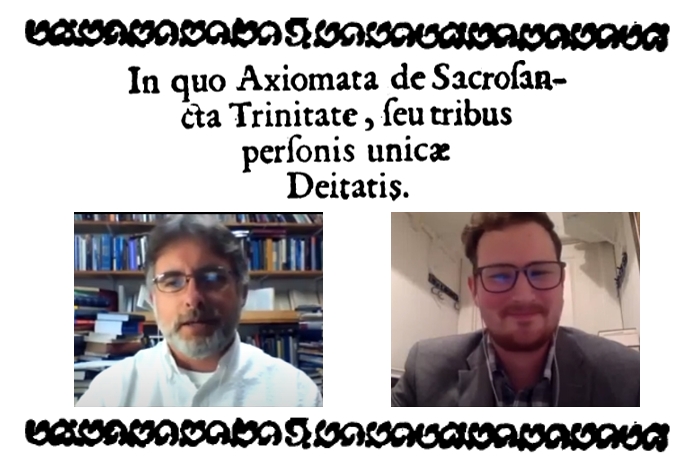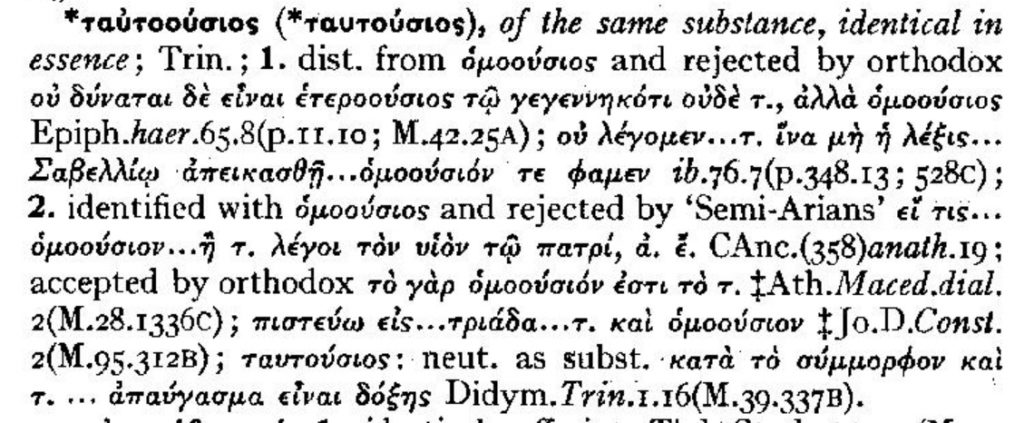
In his fourth axiom on the Trinity, Polanus clarifies how the persons of the Trinity are related to each other by clarifying how they are related to the divine nature. To make the point, he contrasts the right answer, homoousioi, with a number of wrong answers that he states as other compound words building on -ousioi:
Not ετερουσιοι, heterousioi: That would be different substances.
Not συνουσιοι, sunousioi: That would be conjoined substances.
Not μονουσιοι, monousioi:That would be solitary substances.
Not ταυτουσιοι, tautousioi: That would be identical substances.
But ενουσιοι, enousioi: The persons subsisting in the substance.
And of course ομοουσιοι, homoousioi: of the same essence.
Here’s Ryan’s translation, with my footnotes attempting to identify the patristic sources, and then video of our discussion.
Axiom 4. The persons are not ετερουσιοι, of another or different substance—like the Eunomians intend. They are not συνουσιοι, conjoined in essence, as if one person is not from another and does not possess the same common singular essence (such as men do, all having one common essence)—like Epiphanius warned (in his Ancoratus) [1] how Sabellius was saying that the Father and Son do have the same essence, but was denying that one is from another. The persons are not μονουσιοι, each having a solitary essence and having no other individual similar to his own substance, like the sun, moon, and heavens. The persons are not ταυτουσιοι, as Epiphanius [2] warned against Paul of Samosata. Rather, the persons are ενουσιοι, as Anastasius of Antioch [3] says in the apostle’s words in Hebrews 1:3, because each person subsists in the essence. And they are ομοουσιοι, as Athanasius teaches in his Exposition of the Faith [4]: coessential, consubstantial, or having one and the same essence, even a singular essence and the same in number with the distinction and procession of one from another. This is because one says those are properly ομοουσιοι only where one of them is from another and receives the same essence from him. Yes, the Fathers of the Council of Antioch [5] denied in so many words against Paul Samosatenum that the Son is ομοουσιος with the Father, but they did not deny this absolutely speaking, but according to what Samosatenum thought. He was taking the word in a corporeal way and saying that the Son is consubstantial with the Father parallel to how a man is consubstantial with another man, with the result that the two substances belong to the same species. Hence Samosatenus confessed ομοουσιος wrongly. The Fathers of the Nicene Council, on the other hand, have declared that the Son is ομοουσιος with the Father, in that very sense used by both Dionysius of Rome and Dionysius of Alexandria, [6] who were more ancient than the Council of Antioch.
___________________
[1] Epiphanius of Cyprus, Ancoratus, 6.
[2] ibid
[3] Anastasius of Antioch, cannot locate text.
[4] Athanasius, Expositio Fidei, unclear where.
[5] A synod at Antioch in 268 condemned Paul of Samosata. Polanus’ account of why they rejected his use of the word homoousios follows Athanasius’ explanation of it in De Synodis 43-45.
[6] Here Polanus again follows Athanasius’ work in reconciling statements made by third-century bishops; see De Sententia Dionysii, 17.
Some notes:
My attempts to identify Polanus’ sources are rough. Sometimes it’s obvious what he’s referring to, and other times it leads to a real thicket of problems. I’d love to hear from anybody who can identify the Anastasius text.
Some of Polanus’ decision to teach this material using a series of -ousia compounds seems to come straight from Epiphanius. Check out the relevant passage in Young Kim’s recent translation of Ancoratus:

Polanus is often getting his patristic texts by way of an already well-developed Protestant tradition of handing on favorite passages. In this case, these same -ousia compounds can be found in Martin Chemnitz’ The Two Natures, chapter 2, p. 43.
Polanus himself had already assembled strategic passages from the fathers in his earlier work Symphonia Catholica. In fact, at p. 119 of the Symphonia, he argues the thesis that the pre-Nicene fathers were not in disagreement with the council of Nicaea. To prove this, he cites Justin Martyr, Athenagoras, Clement, Origen, Tertullian, and Dionysius of Alexandria.
Finally, in the discussion we got a little confused over ενουσιοι, where Ryan translated εν as “one” because he thought the mark over the ε was a rough breathing mark. And we’re not even using accents and breath marks in the translation, because life is short and we’ve got our hands full talking through a never-before-translated Latin text. But just to be clear: it’s “in,” not “one.” What Polanus is arguing here is that the Father, Son and Spirit each subsist in the essence; he’s not just re-making the point about their unity.
Update: It occurred to me that I should have just looked up tautousios in Lampe’s Lexicon of Patristic Greek. Sure enough, its listed (though spelled slightly differently), and there’s a nice guide to some key occurrences of it, including a use by Epiphanius. And here’s an indication that it’s a highly ambiguous word even to Greek patristic authors: definition 2 indicates that it was used to mean the same thing as homoousios and that semi-Arians therefore wouldn’t accept it.
